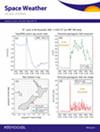Mapping Geoelectric Field Hazards in Ireland
IF 3.7
2区 地球科学
引用次数: 0
Abstract
Geoelectric fields are generated at the Earth's surface and can lead to the induction of hazardous geomagnetically induced currents (GIC) in infrastructure like power grids, railways and pipelines during geomagnetic storms. Magnitude and orientation of the geoelectric fields, in relation to the infrastructure, are key features needed to determine the intensity of GIC. Here, we developed the first geoelectric hazard map for the island of Ireland, with the aim of providing detailed information that can help stakeholders mitigate the impact of GICs. The hazard map was developed by modeling and mapping the geoelectric field across Ireland for 28 years (1991–2018) using magnetic field data with magnetotelluric transfer functions. The approach for developing the hazard map calculates the probability of exceeding a hazardous geoelectric field threshold (500 mV/km) during large geomagnetic storms, taking directionality and amplitude into account. We found hazardous geoelectric fields to be mostly localized in areas in the west, south-west and northern coast. We observed that the geoelectric field have a stronger dominant orientation than the orientation of the geomagnetic field, often constraining the hazardous geoelectric field in particular directions only. We demonstrate a seasonal/diurnal effect is present in the geoelectric field time series. The impact of galvanic distortion was also assessed, and we demonstrate that there is a significant difference in terms of amplitude and direction between both models.爱尔兰地电场危险绘图
地电场产生于地球表面,在地磁暴期间会在电网、铁路和管道等基础设施中诱发危险的地磁感应电流(GIC)。与基础设施相关的地电场的大小和方向是确定 GIC 强度所需的关键特征。在此,我们为爱尔兰岛绘制了第一张地电危害图,目的是提供详细信息,帮助利益相关者减轻地磁风暴的影响。该危害图是通过使用磁场数据和磁小陀螺转移函数对爱尔兰 28 年(1991-2018 年)的地质电场进行建模和绘图而绘制的。绘制危险地图的方法是计算大型地磁暴期间超过危险地电场阈值(500 mV/km)的概率,同时考虑方向性和振幅。我们发现危险地电场主要集中在西部、西南部和北部沿海地区。我们观察到,地电场的主导方向强于地磁场的方向,往往只在特定方向上限制了危险地电场。我们证明地电场时间序列中存在季节/日效应。我们还评估了电流畸变的影响,结果表明两种模型在振幅和方向上存在显著差异。
本文章由计算机程序翻译,如有差异,请以英文原文为准。
求助全文
约1分钟内获得全文
求助全文

 求助内容:
求助内容: 应助结果提醒方式:
应助结果提醒方式:


